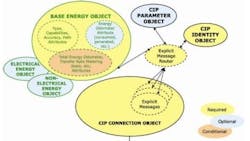Industrial networks get energy reporting features
Industrial automation applications using EtherNet/IP, DeviceNet, CompoNet and ControlNet networks will soon be able to more easily get energy usage information about devices hooked into these networks.
ODVA, the organization that controls standards for the four kinds of networks, has come up with a new energy object used to report energy for all energy and resource types. ODVA's energy reporting methodology is harmonized with energy reporting standards defined by the Global Reporting Initiative (GRI), which promotes transparent and reliable exchange of sustainability information. ODVA’s energy object also follows the Environmental Indicator Protocol EN3 of the G3 Sustainability Reporting Guidelines, which is the foundation of the GRI reporting framework.
ODVA says its energy object will let manufacturers build a virtual “Energy Usage Tree” representing energy consumption throughout an enterprise. The spec includes an electrical energy object that provides electrical energy-specific data reporting capabilities and diagnostics for devices that consume or produce electrical energy within industrial facilities. The spec also defines a non-electrical energy object for reporting consumption and production of non-electrical energy data such as that for natural gas, fuel oil, and steam.
Potential users of the ODVA energy object can get a feel for how it will work by examining some of the attributes it defines. For example, there are attributes for both real and reactive energy consumed, as well as for real and reactive energy generated. The object also has attributes for current in each leg of a three-phase system, and for time-rate of energy production or consumption.
Another point to note: The units of the attributes are specified in real units such as kilowatt-hours rather than in raw data that must be translated into physical units.
Other attributes likely to be widely implemented in the energy object include those for true power factor for each phase, phase rotation, and measurement accuracy.
To help ensure the success of its Optimization of Energy Usage (OEU)efforts, ODVA has established a Special Interest Group for Energy Applications to develop the neccessary standards. ODVA figures OEU will start generating return-on-investment for users in 2012 with continuing incremental improvements possible each year as the focus and deliverables of ODVA’s energy initiative progress through three phases from 2011 to 2020.
More info:http://www.odva.org/Portals/0/Library/Publications_Numbered/PUB00246_ODVA_Optimization_of_Energy_Usage_R0.pdf
